 |

Botanical Society of the British Isles
Field Meeting in Western Portugal
led by Teresa Farino and John Muddeman
19 - 26 March 2006
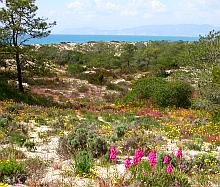 Tróia Sand-dunes© Teresa Farino Fourteen BSBI members escaped the British winter and flew to Lisbon for a week to explore western Portugal. Although the weather let us down on occasion, we explored a series of interesting habitats, from limestone rock-gardens to Atlantic sand-dunes, and from salt-marsh to Cork Oak montados, encountering a wide range of southern European spring flowers in the process. Tróia Sand-dunes© Teresa Farino Fourteen BSBI members escaped the British winter and flew to Lisbon for a week to explore western Portugal. Although the weather let us down on occasion, we explored a series of interesting habitats, from limestone rock-gardens to Atlantic sand-dunes, and from salt-marsh to Cork Oak montados, encountering a wide range of southern European spring flowers in the process.
19 March - Samouco and Sapal das Hortas
The group was met by Teresa Farino and John Muddeman at Lisbon airport and was quickly transported over the impressive Vasco da Gama suspension bridge (built for Expo '98) across the River Tejo, to arrive (albeit via a rather tortuous route) at the Samouco beach on the south side of the estuary. Whilst enjoying a late lunch, we were able to observe Greater Flamingo, Cattle Egret, Dunlin, Ringed Plover and Sandwich Tern, after which we wandered slowly along the shoreline in search of colonising psammophiles.
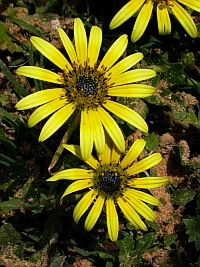 Plain Treasureflower
Plain Treasureflower
Arctotheca calendula
© Teresa Farino
We were able to recognise British species such as Cakile maritima (Sea Rocket), Lupinus angustifolius (Narrow-leaved Lupin), Echium plantagineum (Purple Viper's-bugloss, extremely rare in the UK) and Anisantha diandra (Great Brome), growing together with quite a few not found in Britain: Malcolmia littorea (Sand Stock), Emex spinosa (Emex), the beautiful, deep-blue Iberian endemic Anchusa calcarea, a large-flowered yellow toadflax Linaria spartea, Arctotheca calendula (Plain Treasureflower, a yellow composite native to South Africa), and the distinctive grass Cutandia maritima.
We then drove a few kilometres to the east, through the town of Alcochete, to the saltmarsh and wet pastures behind the shore at Sapal das Hortas. The distinctive crowns of Pinus pinea
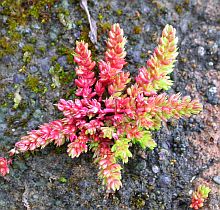 Mossy Stonecrop
Mossy Stonecrop
Crassula tillaea
© Teresa Farino
(Stone or Umbrella Pine) topped a nearby ridge, while the marshy areas were home to Atriplex halimus (Shrubby Orache), a fine-leaved sea-lavender Limonium ferulaceum, the wormwood Artemisia caerulescens and Triglochin bulbosa (Bulbous arrow-grass). Sandy areas nearby supported Crassula tillaea (Mossy Stonecrop), Lathyrus ochrus (Winged Vetchling), Cotula coronopifolia (Buttonweed: another South African invader), Gynandriris sisyrinchium (Barbary Nut) and the first of many drifts of Leucojum trichophyllum (Three-leaved Snowflake), as well as a couple of species which are rather scarce in the UK: Hypochoeris glabra (Smooth Cat's-ear) and Poa infirma (Early Meadow-grass). Trying to photograph the plants meant instantly wet knees: a fairly common event during the week!
20 March - Altiplano de Azóia
Having arrived under the cloak of darkness the previous evening, we awoke to find that the hotel was situated on the crest
of a bleak, windswept promontory. The good news was that the bedrock was limestone and setting off on foot, walking south towards the coast, we soon came upon what would prove to be the first of a whole plethora of orchid species. Barlia robertiana (Giant Orchid) lived up to its English name with respect to stature, but even at this early stage of the season was beginning to go over. As we traversed the limestone pavement more orchids were observed. Aceras anthropophorum (Man Orchid), a few Ophrys speculum (Mirror Ophrys) and the muted hues of the diminutive Ophrys bombyliflora (Bumble-bee Ophrys) were scattered here and there amidst sheets of bright pink Orchis italica (Naked Man Orchid), but most notable were the several plants of Ophrys fusca ssp. dyris, which is not mentioned as occurring in the area in the local flora.
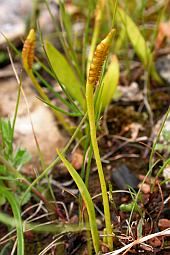 Least Adder's-tongue
Least Adder's-tongue
Ophioglossum lusitanicum
© Teresa Farino
It is always a great privilege to discover species that are rare in Britain growing in profusion in another country. Ophioglossum lusitanicum (Least Adder's- tongue) was, however, not one such species, since only one small colony was found, but Poa bulbosa (Bulbous Meadow-grass) did occur in quantity. More orchids also made an appearance here, including Ophrys scolopax (Woodcock Ophrys) and Orchis papilionacea (Pink Butterfly Orchid), along with a few Narcissus bulbocodium ssp. obesus (Hoop-petticoat Daffodils), a one-leaved squill Scilla monophyllos and the star-of-Bethlehem Ornithogalum orthophyllum. And all this to a background of bird-song supplied courtesy of Dartford and Sardinian Warblers and Corn Buntings.
As we descended towards the sea, we were soon chest-high in dense maquis, fortunately well served by narrow pathways,
where the vivid yellow colour of the Portuguese endemic gorse Ulex densus gave us the impression that it was the
height of summer. A pause for lunch was punctuated by several trips by various members of the party to a small limestone
outcrop just above us, where we located abundant Cheilanthes acrostica and Priscilla found Cosentinia vellea
(Scaly Cheilanthes).
At last we reached the edge of the coastal cliffs, where our target species - duly located - was Euphorbia pedroi, endemic to the Espichel promontory, and unusual for the European mainland in that it is a tree-spurge. In the limestone outcrops in the same area we found Cerinthe gymnandra, the Afro-Iberian endemic shrub Withania frutescens, Ornithogalum concinnum, Dipcadi serotinum (Dipcadi), Muscari neglectum (Grape-hyacinth) and drifts of the delightful Tulipa sylvestris ssp. australis (Wild Tulip).
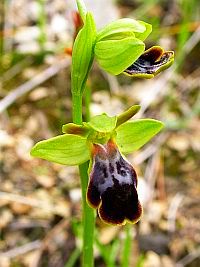 Dull Ophrys
Dull Ophrys
Ophrys fusca ssp. bilunulata
© Teresa Farino
Heading back towards the hotel there were yet still more orchid species to be found. Orchis conica (Conical Orchid) was in short supply, but Ophrys tenthredinifera (Sawfly Ophrys), O. lutea (Yellow Ophrys) and O. fusca ssp. bilunulata (Dull Ophrys) were all fairly commonplace. We also came across a few Arisarum vulgare ssp. simorrhinum (Friar's-cowl) still in flower.
Late afternoon found the party driving westwards towards Cabo Espichel. The first stop was Lagosteiros Bay, where 150 million years ago a herd of dinosaurs left their foot prints on the beach, now preserved in the uplifted and tilted Jurassic limestone. We then visited the sanctuary of Nossa Senhora do Cabo (Our Lady of the Cape), on the very tip of the promontory where, despite the approaching sunset, a few of us attempted to photograph the almost-black flowers of Nonea vesicaria, growing here with Muscari comosum (Tassel Hyacinth).
21 March - Península de Tróia
The Sado Estuary is cut off from the open sea by the long sand spit of the Tróia Peninsula, developed only at the northern tip. A transect across the sandspit takes one from the open sea, through primary dunes, stabilised and fossil dunes through to the brackish areas adjacent to the enclosed estuary.
 Jonopsidium acaule
© Teresa Farino
Jonopsidium acaule
© Teresa Farino
We took the car ferry from the old town of Setúbal across to Tróia, and no sooner had we parked in the botanical reserve in the centre of the spit than we were examining considerable numbers of an as yet unidentified (by us) bush cricket on the Santolina impressa (a Portuguese endemic). Another botanical treasure observed by the roadside was the small but delightful Jonopsidium acaule - dense pincushions of a pale pink crucifer with spoon-shaped yellow green leaves - which is unique to the coast of southern Portugal as a wild plant, although widely cultivated in Europe.
Our overall impression of the flora of the dunes was of abundant pink, yellow and blue, set against a background of grey
green shrubs and an occasional stunted Pinus pinea. The pink was predominantly Silene littorea and tall spikes
of Antirrhinum majus ssp linkianum, and the yellow pertained to Senecio gallicus and two shrubby species
of Halimium - H. calycinum and H. halimifolium - while the scene was further enlivened by the deep blues of the
attractive Anagallis monelli (Shrubby Pimpernel), Anchusa undulata (Undulate Anchusa) and
Lithodora diffusa ssp. lusitanica (Scrambling Gromwell). Several Thekla larks were singing over the low scrub,
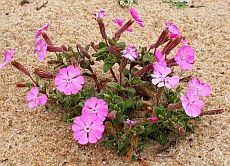 Silene littorea
© Teresa Farino
butterflies seen included Swallowtail, Cleopatra and Small Copper, and we also encountered many individuals of the beautifully
marked, day-flying noctuid moth known as Cerocala scapulosa.
Silene littorea
© Teresa Farino
butterflies seen included Swallowtail, Cleopatra and Small Copper, and we also encountered many individuals of the beautifully
marked, day-flying noctuid moth known as Cerocala scapulosa.
The many species of shrubs included Juniperus oxycedrus (Phoenician Juniper), Cistus salviifolius (Sage-leaved Cistus), Ulex australis ssp. welwitschianus, Lavandula stoechas ssp. luisieri and Armeria pungens (Spiny Thrift), as well as the unusual Corema album (Empetraceae), which is confined to the coasts of western Iberia and North Africa. Growing in the protection of these shrubs were some early flowers of Fritillaria lusitanica, and we also found Cytinus hypocistis here: a member of the Rafflesiaceae, parasitic on the roots of Cistus species.
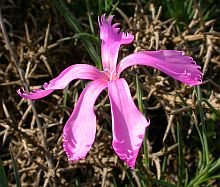 Dianthus broteri
© Teresa Farino
Dianthus broteri
© Teresa Farino
Nearer the sea, the results of convergent evolution made us look closely at the prostrate, grey-leaved and yellow flowered
legumes so that we could distinguish between Medicago marina (Sea Medick) and Lotus creticus (Southern Birdsfoot-trefoil). Also adapted to this unstable habitat were Honckenya peploides (Sea Sandwort), Polygonum maritimum (Sea Knotgrass - extremely rare in the UK), Eryngium maritimum (Sea-holly), the fleshy leaved Thymus carnosus (an Iberian endemic thyme), Crucianella maritima (Coastal Crucianella), the British rarity Otanthus maritimus (Cottonweed), Pancratium maritimum (Sea Daffodil), the distinctive Cyperus capitatus and carpets of Corynephorus canescens (Grey Hair-grass). Our lunch stop overlooking the estuary to the east enabled us to observe the extra large flowers of the Dianthus broteri and to find Sesamoides spathulifolia: a handsome, brown flowered relative of Reseda.
The Tróia sand spit has long been settled by man but the extensive Roman ruins of Cetóbriga were 'closed for restoration', as they have been for the last four years! Nearby, and close to the tidal inlet of Caldeira de Tróia, the fossil dunes were clothed with Pinus pinea, with an understorey of shrubs that included Stauracanthus genistoides, Retama monosperma (White Broom) and Osyris lanceolata. Down among the low brackish vegetation, some of us were delighted to find the emerging spikes of Cistanche phelypaea ssp phelypaea (Cistanche), while others were rewarded with a superb Striped Hawk-moth: both fitting endings to a very enjoyable day.
22 March - Moinho de Baixo and Quinta da Serra
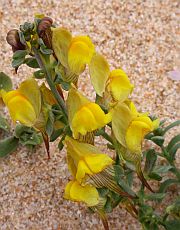 Linaria lamarckii
© Teresa Farino
Linaria lamarckii
© Teresa Farino
While Malcolm went to Lisbon in search of a replacement camera body, the rest of us explored the Atlantic dune system
north of Moinho de Baixo. The vegetation was superficially similar to that of previously visited coastal sands, with abundant Malcolmia littorea, Silene littorea, Lotus creticus and Medicago marina, but the greater westerly exposure also suited familiar species such as Calystegia soldanella (Sea Bindweed) and Ammophila arenaria (Marram). Also prominent were Armeria pungens, Anchusa undulata (its sinuate leaves clearly distinguishing it from A. calcarea), Thymus carnosus, Helichrysum italicum ssp. serotinum, and Artemisia campestris ssp. maritima (Sea Wormwood). We also found good quantities of Polycarpon alsinifolium, while the striking yellow Linaria with glaucous leaves and brownish-purple stripes on the spur was subsequently identified as L. lamarckii.
Reedbeds in a low-lying area signalled an abrupt change in the flora, with Hypericum undulatum (Wavy St John's-wort),
Hydrocotyle vulgaris (Marsh Pennywort), Carex riparia (Greater Pond-sedge) and Cladium mariscus
(Great Fen-sedge) complementing the Phragmites australis, with young fiddleheads of Thelypteris
palustris (Marsh Fern) confirming the presence of a permanent sub-surface drainage system. A further visit next
morning confirmed that an Equisetum, much battered by the winter, was indeed E. ramosissimum
(Branched Horsetail).
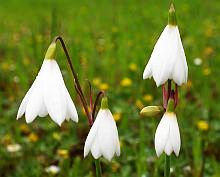 Three-leaved Snowflake
Three-leaved Snowflake
Leucojum trichophyllum
© Teresa Farino
The dunes here, long since stabilised by shelter-belts of Pinus pinea and P. pinaster (Maritime Pine), are
now succumbing to invasions of Carpobrotus edulis and Acacia longifolia, which elsewhere in Portugal have
become a serious threat to coastal vegetation. Here these pinewoods were populated by Muscari comosum,
Ornithopus sativus (Serradella), O. compressus (Yellow Serradella) and glowing sheets of the
Afro-Iberian endemics Scilla monophyllos and Leucojum trichophyllum, plus a polypody that -
like all the other plants seen - was later confirmed as Polypodium cambricum (Southern Polypody).
The final site of the day was Quinta da Serra, a more acidic area on the landward side of the Serra da Arrábida.
Under a canopy of Quercus faginea ssp. broteri (the endemic subspecies of Lusitanian oak) and Erica
arborea (Tree Heath), the poorly-draining soil favoured Selaginella denticulata (Mediterranean Selaginella),
Asplenium onopteris (Irish Spleenwort) (but not, it seems, A. adiantum-nigrum (Black Spleenwort), as we
first thought), a plant of Anogramma leptophylla (Jersey Fern) fully 18cm tall, Juncus capitatus
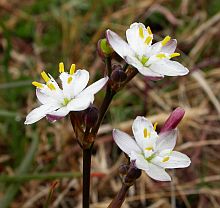 Kerry Lily
Kerry Lily
Simethis planifolia
© Teresa Farino
(Dwarf Rush), Schoenus nigricans (Black Bog-rush), Carex panicea (Carnation Sedge) and other plants of
wet places, including the sprawling Hypericum tomentosum.
On drier banks we found Briza minor (Lesser Quaking-grass) and a small but delightful colony of Simethis planifolia (Kerry Lily). Good quantities of Aristolochia paucinervis put Teresa on the qui vive for the Spanish Festoon butterfly, whose larval food plant is birthwort, and sure enough a pristine, just-emerged specimen was found and duly photographed before it took its first flight. A small stand of Orchis papilionacea was just coming into flower, while on sandstone outcrops Narcissus bulbocodium ssp. obesus, Tulipa sylvestris ssp. australis and a few plants of Scilla verna (Spring Squill) were at their best. We also found a couple of rather tired Romulea bulbocodium, Lynne collected leaves of Hyacinthoides hispanica (Spanish Bluebell) for DNA analysis at Kew and we walked back to the vehicles in the shade of Fraxinus angustifolia (Narrow-leaved Ash) and Viburnum tinus (Laurustinus).
23 March - Pinheiro
Our visit to the area near Pinheiro was the furthest east we were to explore during our stay in Portugal, taking us into the Quercus suber (Cork Oak) montados (wood-pasture) bordering the 5,000-hectare privately owned estate of Herdade do Pinheiro. Once they are at least 25 years old, Quercus suber trees are stripped of the outer bark in early summer every 9 years, the cork still being used not only in the wine industry but in countless other ways ranging from footwear to tiles. As the oaks in a montado are not all of the same age, the thickness of the cork varies and therefore not all are harvested in the same year. Hence we noticed that each tree had a number painted on the trunk to indicate the year of the last 'strip'.
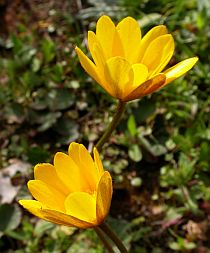 Palmate Anemone
Palmate Anemone
Anemone palmata
© Teresa Farino
Here, the large, old evergreen trees formed a canopy over a light understorey consisting of Cistus salviifolius and C. psilosepalus with Halimium lasianthum and Phillyrea latifolia; after a little diligent searching, we also found the vividly purple spikes of Limodorum abortivum (Violet Limodore). In the glades between the trees were scattered the bright blue Scilla monophyllos and the golden Anemone palmata (Palmate Anemone). Close by was a good stand of tall Pinus pinea, with large, heavy cones containing the edible pine kernels, and next to them an area of lower scrub where we had our first sighting of Iberian Azure-winged Magpies (Cyanopica cooki) swooping between the bushes.
Adjacent to the oaks and pines was a seasonally wet area with many small pools in the depressions where we recorded some familiar plants such as Isolepis setacea (Bristle Club-rush), Ranunculus sceleratus (Celery-leaved Buttercup) and Lycopus europaeus (Gypsywort), as well as Lythrum hyssopifolia (Grass-poly; extremely rare in the UK), with Juncus effusus (Soft-rush) and Typha domingensis at the edges of the pools. Huge tussocks of Carex paniculata (Greater Tussock-sedge) with even larger stands of Arundo donax (Giant Reed) formed a backdrop to the area, which was also rich in bird life. A Marsh Harrier hunted above us as we listened to the calls of the Iberian Chiffchaff, Siskin, Bullfinch and Chaffinch. A glistening Iberian Water Frog was spotted at the edge of a pool bordered by a bright green sward of Vulpia bromoides (Squirreltail Fescue).
24 March - Bottle-nosed Dolphins and Portinho
Friday morning saw the group back in Setúbal, where we were given an illustrated talk about the population of Bottle-nosed Dolphins (Tursiops truncatus) that inhabits the Sado Estuary. This population comprises about 25 individuals who enjoy such a good diet from the plentiful fish stocks of the estuary that they grow to an unusually large size: over 4m in length. All of the individuals in the estuary are known to the staff of Vertigem Azul from the unique configuration of their dorsal fins.
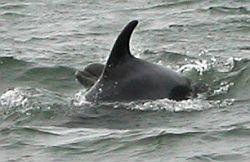 Bottle-nosed Dolphins
Bottle-nosed Dolphins
Tursiops truncatus
© Teresa Farino
At the completion of the talk, we were led by our captain Pedro and his little dog to a high-powered rigid inflatable boat (RIB), equipped with two enormous outboard engines. After being issued with lifejackets, we arranged ourselves along the sides of the RIB, hanging on tenaciously as the engines roared into life, to be powered through the waves back from the mouth of the estuary to the sheltered waters towards its rear. Once the engines had been throttled back and we began to drift, it was not long before the first dolphin was spotted as a distant fin arched across the waves.
Gradually they worked their way closer to us. We could see they were hunting and corralling their prey into tighter concentrations before feeding from the dense mass of fish. Indeed as they came ever closer it was possible to see in advance where a dolphin would surface by the fish which leaped into the air in their attempts to avoid their pursuers. In this way we were lucky to get close views of dolphins leaping, often in pairs, just by the boat. Our captain repositioned the boat several times in order to avoid stressing individual groups of dolphins, and each time we moved to a slightly different location the dolphins came towards us and so, as far as we could tell, our activities were not inconveniencing them.
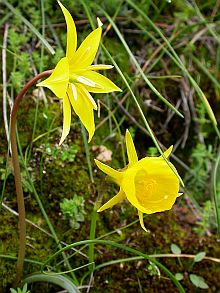 Tulipa sylvestris ssp. australis and
Tulipa sylvestris ssp. australis and
Narcissus bulbocodium ssp. obesus
© Teresa Farino
After an exhilarating return journey, which was punctuated by some slower passages in which we explored the landward side of the Tróia spit, we re-boarded the minibuses and set off for the Serra da Arrábida, where we stopped for lunch at a lay-by with magnificent views back across the mouth of the Sado estuary. This area, just above a massive, sprawling, quarry complex, was botanically rewarding and contained enormous numbers of Tulipa sylvestris ssp. australis and Narcissus bulbocodium ssp. obesus plus Asplenium trichomanes ssp. quadrivalens (Maidenhair Spleenwort), Astragalus boeticus, the Iberian endemic Genista tournefortii, Ferula communis (Giant Fennel), Gennaria diphylla (Two-leaved Gennaria) and Cephalanthera longifolia (Sword-leaved Helleborine).
On our way to the Portinho road, down which we were to walk, we made a brief stop at one of the high points of the Serra and here we found our first Neotinea maculata (Dense-flowered Orchid) and Orchis mascula (Early Purple Orchid) of the trip. Our walk down the lane to the picturesque seaside fishing port of Portinho became a masterclass in the identification of the evergreen trees and shrubs of the maquis which were so conveniently juxtaposed along this short stretch of road. Among the herbs seen here were Lathyrus clymenum, L. sphaericus, Scorpiurus sulcatus, Vicia lutea (Yellow-vetch), Echium creticum, Stachys ocymastrum, Orobanche amethystea, Phagnalon saxatile and Gladiolus illyricus (Wild Gladiolus).
25 March - Serra de Louro
Our last day began as usual with low cloud and attempting to mizzle, but by midday it was sunny and sultry. Just right for lunch, except that the botanical interest of our route meant that we took 5½ hours for a 6km walk so we did not actually eat it until 4 pm! The walk was along the limestone ridge of the Serra de Louro, topped by a series of windmills with canvas sails used in late summer to grind grain.
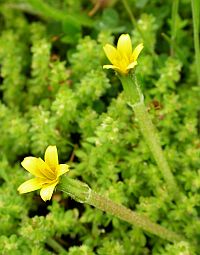 Hyoseris scabra
© Teresa Farino
Hyoseris scabra
© Teresa Farino
The flora was rich and similar to that of the Serra da Arrábida, but notable species not seen before (or not in any quantity) included Alyssum simplex, Trifolium stellatum (Starry Clover), dark-blue and yellow Convolvulus tricolor (Dwarf Convolvulus), Cynoglossum clandestinum and C. creticum (Blue Hound's-tongue), the former bearing flowers which never open, Bellardia trixago (Bellardia) in bud, Galium murale, a distinctive little composite later identified by Sarah as Hyoseris scabra, Arum italicum (Italian Lords-and-ladies), a fine patch of Asphodelus fistulosus (Hollow-stemmed Asphodel) and Allium neapolitanum and A. triquetrum (Neapolitan and Three-cornered Garlic, respectively).
In the Quercus faginea woods below the ridge-top, Mark located several Paeonia broteri (Western Peony), but
unfortunately in bud rather than flower, and on the limestone slabs of the ridge was a mass of Saxifraga granulata
(Meadow Saxifrage), here growing in rock crevices rather than in grassy meadows where one usually finds it in Britain.
A wealth of orchids included Aceras anthropophorum, Orchis italica and O. conica, scattered amidst
Ophrys bombyliflora, O. fusca ssp. bilunulata and O. lutea. Half way along the walk there was
a grassy slope with 50 or so spikes of Ophrys sphegodes (Early Spider Orchid), which some authorities consider
to belong to the subspecies (or even full species) incubacea. However, one of the most interesting finds
of the day was not actually discovered until several weeks later: close to the populations of Ophrys speculum
which we discovered early on in the walk, several of us photographed some reddish wasps, which were later identified by
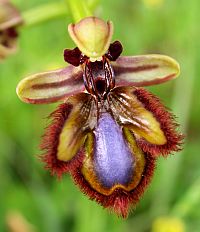 Mirror Ophrys
Mirror Ophrys
Ophrys speculum
© Teresa Farino
one of Malcolm's colleagues as Dasyscolia ciliata - the pollinator of the said ophrys!
The sun brought out at least ten species of butterfly including Swallowtail, Spanish Festoon, Green-striped White, Clouded Yellow, Cleopatra and Painted Lady. We had excellent views of Short-toed Eagle and a party of Hawfinches, as well as spotting a more distant Bonelli's Eagle, but a Western Three-toed Skink curled up by the path did not wait quite long enough to have its picture taken.
In the late afternoon we visited Sesimbra castle, dating from the 13th and 14th centuries, of which the most impressive feature is the encircling wall. Round the castle flew three Alpine Swifts, while at the foot of the mound there was an elusive Firecrest singing. Almost the last plant of the trip was an impressive stand of woundwort, later identified by Sarah at Reading as Stachys germanica ssp. lusitanica.
On returning to our hotel most of the group went out again almost immediately to search for bats by
the Lagoa de Albufeira, using Ross and Lynn's bat detectors.As well as tracking down Common and Kuhl's
Pipistrelles and Serotine, we saw Purple and Night Herons flying across the reedbed,
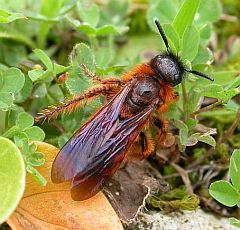 Dasyscolia ciliata
© Teresa Farino
and heard Purple Gallinule.
Dasyscolia ciliata
© Teresa Farino
and heard Purple Gallinule.
After a week's botanising, the broomrape growing in the lawn in front of our hotel had still not come into flower, so remained unidentified, but the Ophrys lutea beside it were at their best…
This report was written by the members of the party - Ross Baker, Arthur Copping, Jane and Maurice Croft, John Edgington, Malcolm Edmunds, Lynne Farrell, Rita Hemsley, Mark and Clare Kitchen, Ann Sankey, Sarah Stille, Priscilla Tolfree and Lynn Whitfield - and was edited by Teresa Farino. It was previously published in BSBI News 103; 41-46 (September 2006).
Botanical holidays in Spain and Portugal:
A Feast of Flowers - botanical holidays in the Picos de Europa
Reports of other botanical trips in Spain and Portugal:
IWT Feast of Flowers in the Picos de Europa - Trip report 2009
BSBI Botanical Tour in the Castilian Páramos - Trip Report 2009
BSBI Botanical Tour in the Valle de Benasque - Trip Report 2008
BSBI Botanical Tour in the Sierra de Grazalema - Trip Report 2007
BSBI Botanical Tour to the Catalan Pyrenees - Trip Report 2005
BSBI Botanical Tour of the Picos de Europa - Trip Report 2004
Related information:
Wildlife of western Portugal - Serra da Arrábida
Wildlife of western Portugal - The Sado estuary
Read about Teresa Farino
Botanical holidays in Spain & Portugal
|